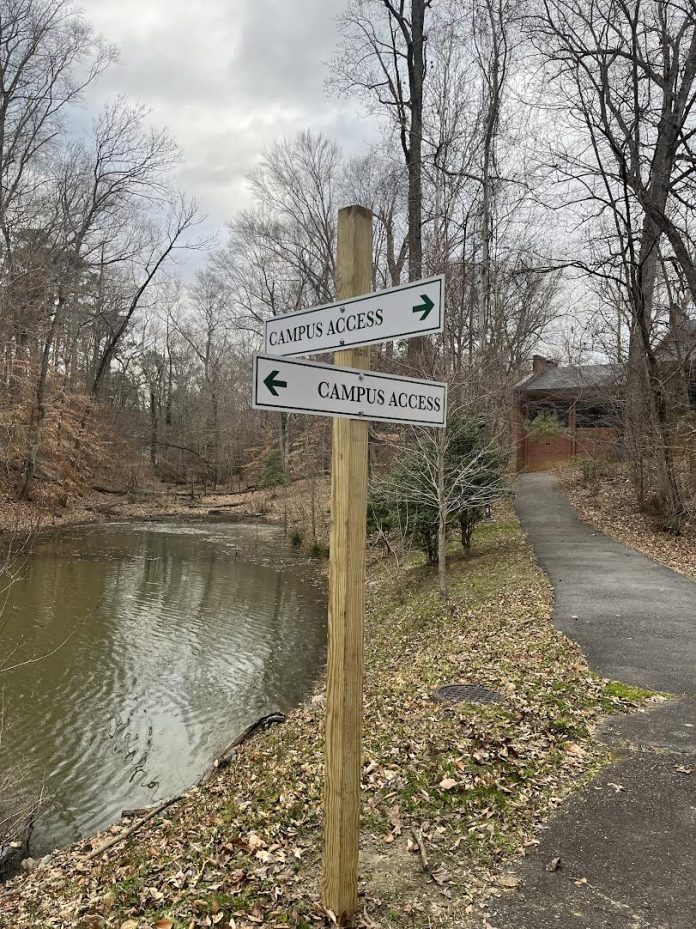Veronica Bondi is a freshman at the College of William and Mary. She hasn’t decided what she’s majoring in yet, but she’s interested in English, Marketing and Government and she is planning on double majoring. She is a copy editor for The Flat Hat, a Facilitator-in-Training for Tribe Innovation, a Writing Resources Center Trainee and a member of Library Ambassadors. Email Veronica at vabondi@email.wm.edu.
The views expressed in the article are the author’s own.
Editor’s Note: The signs to be discussed in the article were placed by the contractor for the Sadler Center expansion to help reroute pedestrian traffic due to the closure of a pathway between Sadler and the McLeod Tyler Wellness Center. The contractor wanted to provide guidance to those who may not be familiar enough with campus to know of an alternate route. The signs are temporary and will come down around the end of the semester when the pathway opens again.
If you’ve taken the trails in the past couple of weeks, I’m sure you’ve seen the useless signs that have cropped up. Of moderate height, made with unassuming wooden poles and simple plaques, the signs are not attention grabbers. That is, until you take a minute to read what they say.
Aside from the bigger sign at the main entrance of the trails, the vast majority of them read: “Campus Access.” Nestled on one side of the Crim Dell lies my particular favorite, which features two identical plaques that point in completely opposite directions, epitomizing just how unhelpful this needless addition to our campus really is.
Now, I can see the case for adding signs to the trails. I, myself, made a wrong turn on my first day of classes, winding up in the outer reaches of New Campus, far away from the desired St. George Tucker Hall. What I can’t understand is why someone decided a vague umbrella term would suffice for denoting all areas of campus not located within the Sadler Center.
It is not as though there are no landmark locations at the other end of the trails. They lead to various dorms, The Caf, Earl Gregg Swem Library and more — the names of which would have made excellent labels and provided meaningful directional aid. Or perhaps the College could have marked intersections with rudimentary street signs, enabling students to give easy-to-follow directions to anyone lost on the trail (“Take a left at Sign A, then go straight until you see Sign B…” etc). The administration might as well have done nothing at all with how much the signs add, or rather don’t, to the navigability of campus.
This begs a different question entirely. Why are the signs even up in the first place? Sure, I can see their potential utility, but it is not as though they fulfill a pressing need or solve an important problem. I got lost on the trails once — and never again. Students, the trails’ most common users, quickly get the hang of navigating them. The locals walking their dogs seem to have their bearings too. New students and families from college tours would be the only ones to benefit from signage at all. Provided the signs were actually helpful, that is. Which the current ones are not.
I do not know who made the decision to approve the project, useless vague signs and all. Or why attention and resources were directed towards a minor issue when more pressing ones remain unresolved. Of course, pursuing one directive does not remove one’s ability to pursue others. Nor am I saying that the College of William and Mary should only focus on the most important of issues and ignore the smaller ones that only impact students’ quality of life on campus. But why is it that these signs were erected when Cabell Hall remains closed with no sign of construction, when the weekend food offerings remain so limited and unvaried that it has become a chore to eat, and when viable long-term solutions to the housing crisis have not been proposed?
The signs are a daily reminder of the resource mismanagement, cut corners and rushed projects that, at best, make little to no impact on student lives and, at worst, cause headaches that plague students for years (One Tribe Place, I’m looking at you). The College needs to get their priorities in order; more is not always better. A project’s completion is only worth as much as its impact on the College’s community — and the signs barely add anything at all.






























Aren’t they just up because the walkway next to the Wellness Center is closed for construction?